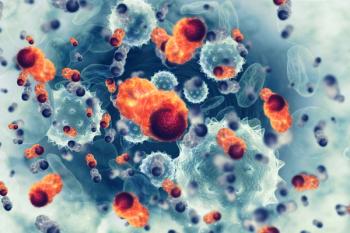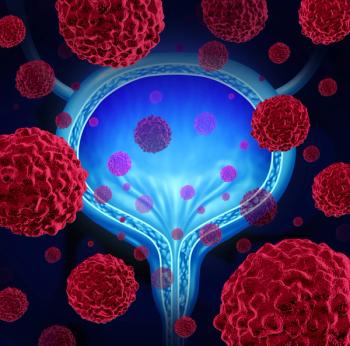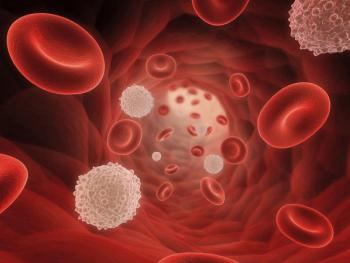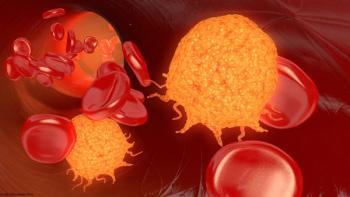
NeuroSAFE Improves Erectile Function, Urinary Continence in Prostate Cancer
The adverse effect profile was similar among patients with prostate cancer using NeuroSAFE-assisted RARP vs standard RARP.
NeuroSAFE-guided nerve sparing during robot-assisted radical prostatectomy (RARP) improved patient-reported 12-month International Index of Erectile Function (IIEF)–5 scores and short-term urinary continence, according to results from the phase 3 NeuroSAFE PROOF (NCT03317990) trial published in The Lancet Oncology.1
At a median follow-up of 12.3 months (IQR, 11.8-12.7), efficacy data from the trial revealed that the mean IIEF-5 scores were significantly higher in patients undergoing surgery with NeuroSAFE at 12.7 (SD, 8.0) vs 9.7 (SD, 7.5) in those who underwent standard RARP (adjusted mean difference, 3.18; 95% CI, 1.62-4.75; P <.0001). Additionally, a similar benefit was seen in IIEF-6 scores: 15.3 (SD, 9.7) vs 11.5 (SD, 9.0) in each respective population (adjusted mean difference, 3.92; 95% CI, 2.01-5.83; P <.0001).
Patients in the NeuroSAFE group saw significant decreases in International Consultation on Incontinence Questionnaire (ICIQ) scores. The 3-month ICIQ scores among the NeuroSAFE and standard RARP groups were 5.8 (SD, 4.1) and 7.4 (SD, 5.2), respectively (adjusted mean difference, –1.41; 95% CI, –2.42 to –0.41; P = .006). Additionally, at 6 months, scores were 4.5 (SD, 4.2) and 5.1 (SD, 4.7) in the respective groups (adjusted mean difference, –0.37; 95% CI, –1.35 to 0.62; P = .46).
“Prostate cancer surgery is a life-saving option for lots of [patients], but it’s a major procedure that can cause [adverse] effects [AEs, such as] erection problems,” Matthew Hobbs, MD, director of Research at Prostate Cancer UK, said in a news release.2 “A major challenge we face is how to cure [patients] but also ensure they can live life to the [fullest] afterwards. This study is promising and provides evidence that innovative types of surgery can reduce erectile dysfunction in some [patients]. However, more research is needed to prove whether NeuroSAFE is as effective as traditional techniques at delivering a complete cure.”
Patients with non-metastatic prostate cancer eligible for RARP were randomly assigned to receive NeuroSAFE-based RARP (n = 204) or standard RARP (n = 203). Standard RARP was performed by an experienced RARP surgeon using the DaVinci surgical system per NHS standard-of-care protocol.
Patients receiving NeuroSAFE-based RARP underwent initial postero-lateral dissection followed by prostate extraction. Then, segments from the dissection were snap frozen, sectioned, and stained with hematoxylin and eosin before examination by a consultant genitourinary histopathologist. The margins were considered negative if the sides of a section were free of prostate cancer cells.
In the event of positive margins, a secondary resection was recommended if: more than 1 section was positive; there was a prostate cancer Gleason grade 4 pattern or higher; or more than 2 mm of Gleason grade 3 pattern was observed in a single section of an inked margin. Secondary resections encompassed a full excision of the entire ipsilateral neuro-vascular bundle.
The primary end point of the study was erectile function at 12 months assessed by IIEF-5. Secondary end points included the difference in ICIQ scores at 3 and 6 months, and the difference in IIEF-6 scores. Exploratory end points included time from surgery to erectile function recovery, time to urinary continence recovery, and positive surgical margin rates.
The 12-month rates of IIEF-5 scores of 21 or greater were 20% in the NeuroSAFE group vs 14% in the standard RARP group. Additionally, 39% vs 23% of the respective groups had no or mild erectile dysfunction at 12 months. Furthermore, small positive margins were observed in 21% vs 13%, respectively, and large or multifocal positive margins were observed in 14% vs 16%.
A total of 4% of patients in the NeuroSAFE group and 3% of the standard RARP group experienced prostate-specific antigen (PSA) persistence. In the respective groups, 6% and 4% experienced biochemical recurrence, and 4% and 1% underwent adjuvant treatment.
There were 20 AEs and 6 serious AEs observed in the NeuroSAFE group (n = 182) and 25 AEs and 5 serious AEs in the standard RARP group (n = 188). In the standard RARP group, 1 patient experienced 2 serious AEs. A total of 4 patients died within 12 months of surgery: 2 in the NeuroSAFE group due to myocardial infarction and co-occurring cancer and 2 in the standard RARP group due to co-occurring cancer and an unknown cause, with none considered related to prostate cancer or surgery.
References
- Dinneen E, Almeida-Magana R, Al-Hammouri T, et al. Effect of NeuroSAFE-guided RARP versus standard RARP on erectile function and urinary continence in patients with localised prostate cancer (NeuroSAFE PROOF): a multicentre, patient-blinded, randomised, controlled phase 3 trial. Lancet Oncol. Published online March 24, 2025. doi:10.1016/S1470-2045(25)00091-9
- Sample I. Prostate cancer surgery breakthrough offers hope for erectile function. News release. The Guardian. March 24, 2025. Accessed March 24, 2025. https://tinyurl.com/3us729ha
Newsletter
Stay up to date on recent advances in the multidisciplinary approach to cancer.

















































































